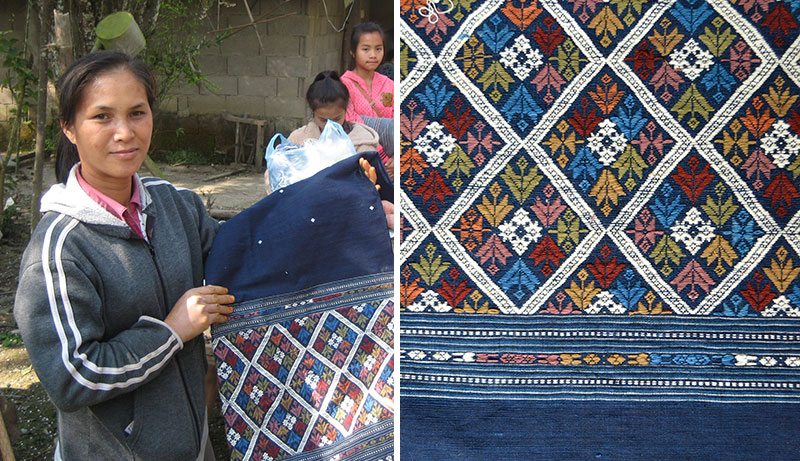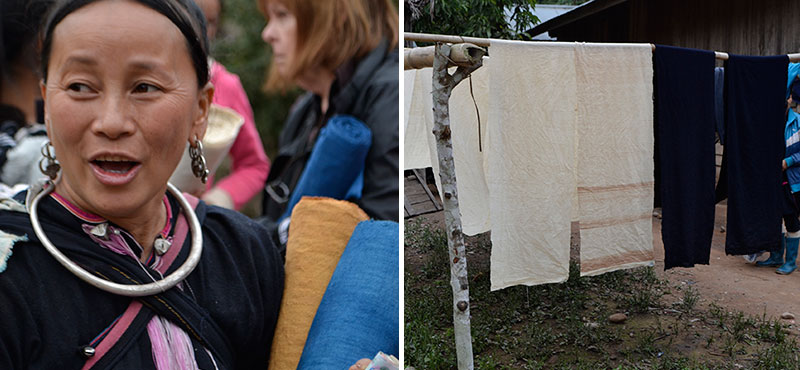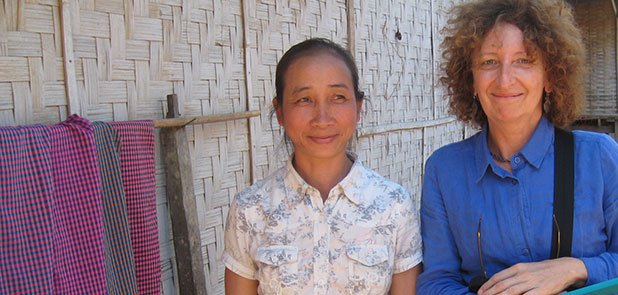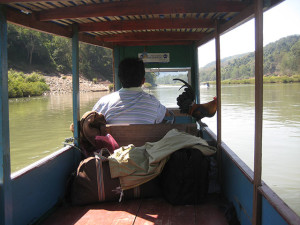Thailand, Laos and the Textile Track – Cloth and their makers
The weavers of Northern Thailand and Laos come from many different and diverse cultural traditions. This had quite an impact on the types of looms, dyes, yarn production and weavers themselves. They weave around their families, sometimes under their homes and when the season allows.
Initially, I felt that my always ever ending excitement at seeing weaving in such seemingly everyday circumstances prevented me for any astute purchases as far as skill level or patterning…it just all seemed surreal. I’m starved of this type of experience. We just don’t get to see weaving in amongst our ordinary lives like that. Everything is hidden away behind doors in buildings.To see such tangibles we could go to the Victorian Tapestry workshop but it seems a world apart and totally unconnected to our daily lives. The ways of conveying quality and supremacy in the craft (probably to justify the high costs and continue the business) also act to make ordinary people feel isolated, although perhaps not intended. In contrast the accessible weavers in Laos can’t command the real costs of their skills as their story can’t be seen through glossy buildings and marketing displays. It’s a conundrum!


The two pieces here are ones that I really liked and I know that for the creative work in them I paid very little. These types of pieces would be cost prohibitive in Australia due to the time taken in their creation. Navone was from Ban Nangang – a Tailue village near Luang Prabang. She also dyed the yarn with all natural dyes. Each motif used a different coloured thread so it was a discontinuous supplementary weft design. It is all handspun cotton. An exquisite piece that I will treasure and one that appeals on all levels to my weaver’s sensibility. The other piece is handspun silk and equally beautiful in every way but I know less about the weaver.

Near Chiang Khong in Thailand, on the beautiful Mekong, we visited Ban Haabtai Village of Tailue weavers. This was my first purchase of a sinh skirt. Already tubed and ready to wear. The older (well older than me and far more skilled) woman on the loom had woven the piece in brightly coloured, heavily patterned cotton. Their weaving room overlooked the river and was an inspiring start to our textile adventure.

The special feature of this tour seemed to unfold in a natural way and that was the enormous variety of textiles. In Ban Nam Dee we encountered handspun, naturally dyed and handwoven lengths of fabric which were for sale. They were narrow widths about seven metres long and really lovely. Oh to have access to cloth like this. I purchased two of them with determination to fit them into our bags, which I did. Some of the indigo dyed fabric was very dark to black, which had been dipped in the dyebath maybe 60 times. This particular group were still wearing their traditional clothes which were quite spectacular. I really liked that village as there was lots going on when we visited.

Here I am photographed with a lovely weaver from Ban Sop Jan, near Nong Khiau. The checked scarves popped up in many places along our journey and although quite simple and often using market purchased yarn, they had a vitality that connected with the place and always looked good.
I’ve exhausted my photos of lovely faces of Thailand and Laos here as I’m too shy to photograph anyone without having some conversation first and usually collect shots of the backs of people. This is a shame (for me) because I think the human face is the most precious vision you gaze upon in life but strangely also the most private and illusive to photograph or draw. This village is only accessible by boat (I think there is some trekking around there too). Whatever your interest any opportunity to go by boat on the Nam Ou river and to this place is worth it. It is very scenic with high cliffs and mountains and a glorious river. You may even be on a boat with a driver and his pet rooster…the rooster of Nam Ou.


I agree with you about taking not taking photos without talking to someone. I usually ask permission to photograph also. But I think making a photo of someone is a bit of a relationship or rather a souvenir of a relationship so I also try to talk to the person–learn something of their life. After all, that’s the real purpose of travel.
I’ve been enjoying your blog!
Kaz, I loved reading about your experiences with the weaving communities of Laos and Thailand! Really fascinating. I’m inspired to make a trip down myself. Thank you for sharing.
Thanks Jan. Yes it really was a great experience.